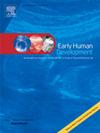葡萄牙样本中父子依恋安全的预测因子
IF 2
3区 医学
Q2 OBSTETRICS & GYNECOLOGY
引用次数: 0
摘要
越来越多的文献表明,父亲在孩子的成长和心理健康中起着至关重要的作用。然而,很少有研究评估父亲作为照顾者和依恋人物的作用,尤其是跨文化的研究。我们通过调查产后第一年婴儿-父亲依恋模式的具体预测因素及其与12个月婴儿-父亲依恋的联系来解决这一差距。样本包括葡萄牙的父子二人组,他们在婴儿出生时被招募,并被纵向追踪到12个月。在3个月和9个月时,在自由游戏和面对面-静止-面对范式(FFSF)中观察二人组。父亲们还报告了他们参与日常照顾活动的情况。在12个月大的时候,在Ainsworth的奇怪情境范式(SSP)中观察父亲-婴儿二人组,父亲报告他们的育儿压力。结果表明,12月龄儿童的安全依恋与父亲和婴儿的多个变量相关,包括9月龄儿童的社会积极调节模式,3月龄和9月龄儿童在自由玩耍时父亲的敏感性和控制力较弱,婴儿的合作程度较高,9月龄儿童的特定照顾活动中父亲的参与程度较高。患有无组织依恋的婴儿的父亲在3个月和9个月时较少参与游戏互动,他们的婴儿在FFSF期间表现出较少的合作行为,更有可能表现出难以安慰的调节模式。二元逻辑回归结果显示,9个月的父亲敏感性和控制预测了安全依恋。这项研究证实了父子关系的独特性。本文章由计算机程序翻译,如有差异,请以英文原文为准。
Predictors of father-infant attachment security in a Portuguese sample
A growing literature shows that fathers play a critical role in their children's development and mental health. However, few studies have evaluated fathers as caregivers and attachment figures, particularly across cultures. We address this gap by investigating specific predictors of infant-father attachment patterns during the first year postpartum and their links to infant-father attachment at 12 months. The sample included Portuguese father-infant dyads who were recruited at the infant's birth and followed longitudinally to 12 months. At 3 and 9 months, dyads were observed during free play and the Face-to-Face Still-Face paradigm (FFSF). Fathers also reported on their involvement in daily caregiving activities. At 12 months, father-infant dyads were observed in Ainsworth's Strange Situation paradigm (SSP), and fathers reported on their parenting stress. Results showed that multiple infant and paternal variables were associated with secure attachment at 12 months, including a social-positive regulatory pattern exhibited in the FFSF at 9 months, greater paternal sensitivity and less control, and more infant cooperation, during free play at 3 and 9 months, and greater paternal involvement in specific caregiving activities at 9 months. Fathers of infants with a disorganized attachment were less involved in play interactions at 3 and 9 months, and their infants exhibited less cooperative behavior and were more likely to display an inconsolable regulatory pattern during the FFSF. Results of binary logistic regression indicate that 9-month paternal sensitivity and control predicted secure attachment. This study confirms the uniqueness of father-infant relationships.
求助全文
通过发布文献求助,成功后即可免费获取论文全文。
去求助
来源期刊

Early human development
医学-妇产科学
CiteScore
4.40
自引率
4.00%
发文量
100
审稿时长
46 days
期刊介绍:
Established as an authoritative, highly cited voice on early human development, Early Human Development provides a unique opportunity for researchers and clinicians to bridge the communication gap between disciplines. Creating a forum for the productive exchange of ideas concerning early human growth and development, the journal publishes original research and clinical papers with particular emphasis on the continuum between fetal life and the perinatal period; aspects of postnatal growth influenced by early events; and the safeguarding of the quality of human survival.
The first comprehensive and interdisciplinary journal in this area of growing importance, Early Human Development offers pertinent contributions to the following subject areas:
Fetology; perinatology; pediatrics; growth and development; obstetrics; reproduction and fertility; epidemiology; behavioural sciences; nutrition and metabolism; teratology; neurology; brain biology; developmental psychology and screening.
 求助内容:
求助内容: 应助结果提醒方式:
应助结果提醒方式:


